Effect of pH on Rheological and Filtration Properties of Water-Based Drilling Fluid Based on Bentonite
Abstract
:1. Introduction
1.1. Bentonite in Drilling Fluids
1.2. Effect of Bentonite on Mud Rheology
1.3. Effect of Bentonite-Based Mud on Drilling Performance
2. Materials and Experimental Procedure
2.1. Materials
2.2. Experimental Program
- Density was measured at ambient conditions for each sample.
- Measurements for the rheological properties such as plastic viscosity (PV), yield point (YP), and gel strength [10-seconds, 10-minutes, 30-minutes readings] were obtained using the mud rheometer at a temperature of 120 °F and atmospheric pressure.
- Filtration test was performed. The test was performed using the high-pressure, high-temperature filter cell under 300 psi differential pressure and 200 °F, and using a 25-micron ceramic disk. The test extended for 40 minutes until no flow out.
- The filtrated volume and filter cake thickness was measured for each mud sample.
3. Results and Discussion
3.1. Mud Density
3.2. Shear-Stress Shear-Rate Behavior
3.3. Rheological Properties
3.4. Filtration Properties
3.5. Recommendation
4. Summary and Conclusions
- The pH significantly affects the mud rheology for the WBDFBOB, and there was no change in the fluid density as it remained constant at 8.8 ppg with changing the pH from 9 to 12.
- The shear-stress vs shear-rate curve changed with changing the pH. Increasing the pH resulted in decreasing the shear-stress over the same shear-rate.
- It is clear that increasing the pH from 8 to 12 resulted in decreasing the plastic viscosity by 53% and the YP by 82%, respectively. The highest value of YP/PV was 1.4 for the mud sample with a pH of 8. The YP/PV ratios were decreased by 64% as the pH increased from 8 to 12.
- Increasing the pH from 8 to 12 had a significant effect on the gel strength where the 10-sec gel strength was decreased by 77%, the 10-min gel strength was decreased by 90%, and the 30 min gel strength was decreased by 95%.
- Changing the pH for the bentonite-based samples had an impact on the filtration properties for the mud. Increasing the pH from 9 to 10 resulted in increasing the filtrated volume by 33% and also increasing the filter cake thickness by 79%.
Author Contributions
Funding
Acknowledgments
Conflicts of Interest
References
- Chilingarian, G.V.; Alp, E.; Al-Salem, M.; Uslu, S.; Gonzales, S.; Dorovi, R.J. Drilling fluid evaluation using yield point-plastic viscosity correlation. Energy Sources 1983, 8, 233–244. [Google Scholar] [CrossRef]
- Jenkins, P.B.; Crockford, A.L. Drilling Costs. In Proceedings of the SPE European Spring Meeting, London, UK, 14–15 April 1975. [Google Scholar] [CrossRef]
- Okoro, E.E.; Dosunmu, A.; Iyuke, S.E. Data on Cost analysis of drilling mud displacement during drilling operation. Data Brief 2018, 19, 535–541. [Google Scholar] [CrossRef] [PubMed]
- Bleier, R. Selecting a drilling fluid. J. Pet. Technol. 1990, 42, 832–834. [Google Scholar] [CrossRef]
- Knox, D.; Jiang, P. Drilling further with water-based fluids-selecting the right lubricant. In Proceedings of the SPE International Symposium on Oilfield Chemistry, The Woodlands, TX, USA, 2–4 February 2005. [Google Scholar] [CrossRef]
- Li, M.C.; Wu, Q.; Song, K.; De Hoop, C.F.; Lee, S.; Qing, Y.; Wu, Y. Cellulose nanocrystals and polyanionic cellulose as additives in bentonite water-based drilling fluids: Rheological modeling and filtration mechanisms. Ind. Eng. Chem. Res. 2015, 55, 133–143. [Google Scholar] [CrossRef]
- Temraz, M.G.; Hassanien, I. Mineralogy and rheological properties of some Egyptian bentonite for drilling fluids. J. Nat. Gas Sci. Eng. 2016, 31, 791–799. [Google Scholar] [CrossRef]
- Song, K.; Wu, Q.; Li, M.C.; Wojtanowicz, A.K.; Dong, L.; Zhang, X.; Ren, S.; Lei, T. Performance of low solid bentonite drilling fluids modified by cellulose nanoparticles. J. Nat. Gas Sci. Eng. 2016, 34, 1403–1411. [Google Scholar] [CrossRef]
- Song, K.; Wu, Q.; Li, M.; Ren, S.; Dong, L.; Zhang, X.; Lei, T.; Kojima, Y. Water-based bentonite drilling fluids modified by novel biopolymer for minimizing fluid loss and formation damage. Colloids Surf. A Physicochem. Eng. Asp. 2016, 507, 58–66. [Google Scholar] [CrossRef]
- Magzoub, M.I. Development of Stable Bentonite for Drilling Fluid Formulations Using Local Sources. Master’s Thesis, King Fahd University of Petroleum and Minerals, Dhahran, Saudi Arabia, 2014. [Google Scholar]
- Li, M.C.; Wu, Q.; Song, K.; French, A.D.; Mei, C.; Lei, T. pH-responsive water-based drilling fluids containing bentonite and chitin nanocrystals. ACS Sustain. Chem. Eng. 2018, 6, 3783–3795. [Google Scholar] [CrossRef]
- Diman, S.F.; Wijeyesekera, D.C. Swelling Characteristics of Bentonite Clay Mats. In Proceedings of the AC&T 3rd Annual Conference, Royal Docks, 2008; Available online: http://hdl.handle.net/10552/781 (accessed on 10 September 2019).
- Clem, A.G.; Doehler, R.W. Industrial applications of bentonite. Clays Clay Miner. 1961, 10, 272–283. [Google Scholar] [CrossRef]
- Lebedenko, F.; Plée, D. Some considerations on the ageing of Na2CO3-activated bentonites. Appl. Clay Sci. 1988, 3, 1–10. [Google Scholar] [CrossRef]
- Al-Homadhi, E.S. Improving Local Bentonite Performance for Drilling Fluids Applications. In Proceedings of the SPE Saudi Arabia Section Technical Symposium, Dhahran, Saudi Arabia, 7–8 May 2007. [Google Scholar] [CrossRef]
- Falode, O.A.; Ehinola, O.A.; Nebeife, P.C. Evaluation of local bentonitic clay as oil well drilling fluids in Nigeria. Appl. Clay Sci. 2008, 39, 19–27. [Google Scholar] [CrossRef]
- Mahto, V.; Sharma, V.P. Rheological study of a water based oil well drilling fluid. J. Pet. Sci. Eng. 2004, 45, 123–128. [Google Scholar] [CrossRef]
- Kirsner, J.; Siems, D.; Burrows-Lawson, K.; Carbajal, D.; Robb, I.; Jamison, D.E. Methods of Drilling Using Flat Rheology Drilling Fluids. U.S. Patent No. 7,456,135, 25 November 2008. [Google Scholar]
- Ahmad, H.M.; Kamal, M.S.; Al-Harthi, M.A. High molecular weight copolymers as rheology modifier and fluid loss additive for water-based drilling fluids. J. Mol. Liq. 2018, 252, 133–143. [Google Scholar] [CrossRef]
- Saboori, R.; Sabbaghi, S.; Kalantariasl, A. Improvement of rheological, filtration and thermal conductivity of bentonite drilling fluid using copper oxide/polyacrylamide nanocomposite. Powder Technol. 2019, 353, 257–266. [Google Scholar] [CrossRef]
- Vryzas, Z.; Kelessidis, V.C. Nano-based drilling fluids: A review. Energies 2017, 10, 540. [Google Scholar] [CrossRef]
- Kosynkin, D.V.; Ceriotti, G.; Wilson, K.C.; Lomeda, J.R.; Scorsone, J.T.; Patel, A.D.; Friedheim, J.E.; Tour, J.M. Graphene oxide as a high-performance fluid-loss-control additive in water-based drilling fluids. ACS Appl. Mater. Interfaces 2011, 4, 222–227. [Google Scholar] [CrossRef]
- William, J.K.M.; Ponmani, S.; Samuel, R.; Nagarajan, R.; Sangwai, J.S. Effect of CuO and ZnO nanofluids in xanthan gum on thermal, electrical and high pressure rheology of water-based drilling fluids. J. Pet. Sci. Eng. 2014, 117, 15–27. [Google Scholar] [CrossRef]
- Yan, L.; Wang, C.; Xu, B.; Sun, J.; Yue, W.; Yang, Z. Preparation of a novel amphiphilic comb-like terpolymer as viscosifying additive in low-solid drilling fluid. Mater. Lett. 2013, 105, 232–235. [Google Scholar] [CrossRef]
- Liu, F.; Jiang, G.; Peng, S.; He, Y.; Wang, J. Amphoteric polymer as an anti-calcium contamination fluid-loss additive in water-based drilling fluids. Energy Fuels 2016, 30, 7221–7228. [Google Scholar] [CrossRef]
- Xie, B.; Liu, X. Thermo-thickening behavior of LCST-based copolymer viscosifier for water-based drilling fluids. J. Pet. Sci. Eng. 2017, 154, 244–251. [Google Scholar] [CrossRef]
- Jung, Y.; Son, Y.H.; Lee, J.K.; Phuoc, T.X.; Soong, Y.; Chyu, M.K. Rheological behavior of clay–nanoparticle hybrid-added bentonite suspensions: Specific role of hybrid additives on the gelation of clay-based fluids. ACS Appl. Mater. Interfaces 2011, 3, 3515–3522. [Google Scholar] [CrossRef] [PubMed]
- Barry, M.M.; Jung, Y.; Lee, J.K.; Phuoc, T.X.; Chyu, M.K. Fluid filtration and rheological properties of nanoparticle additive and intercalated clay hybrid bentonite drilling fluids. J. Pet. Sci. Eng. 2015, 127, 338–346. [Google Scholar] [CrossRef]
- Mao, H.; Qiu, Z.; Shen, Z.; Huang, W. Hydrophobic associated polymer based silica nanoparticles composite with core–shell structure as a filtrate reducer for drilling fluid at utra-high temperature. J. Pet. Sci. Eng. 2015, 129, 1–14. [Google Scholar] [CrossRef]
- Ponmani, S.; Nagarajan, R.; Sangwai, J.S. Effect of nanofluids of CuO and ZnO in polyethylene glycol and polyvinylpyrrolidone on the thermal, electrical, and filtration-loss properties of water-based drilling fluids. SPE J. 2016, 21, 405–415. [Google Scholar] [CrossRef]
- Li, M.C.; Wu, Q.; Song, K.; De Hoop, C.F.; Lee, S.; Qing, Y.; Wu, Y. Cellulose nanoparticles as modifiers for rheology and fluid loss in bentonite water-based fluids. ACS Appl. Mater. Interfaces 2015, 7, 5006–5016. [Google Scholar] [CrossRef] [PubMed]
- Abdo, J.; Zaier, R.; Hassan, E.; Al-Sharji, H.; Al-Shabibi, A. ZnO–clay nanocomposites for enhance drilling at HTHP conditions. Surf. Interface Anal. 2014, 46, 970–974. [Google Scholar] [CrossRef]
- Kanna, A.P.; Savi, S.; Khan, M. Determination of effect bentonite and additives on drilling fluids. Int. Refereed J. Eng. Sci. (IRJES) 2017, 6, 22–28. [Google Scholar]
- Huang, W.; Leong, Y.K.; Chen, T.; Au, P.I.; Liu, X.; Qiu, Z. Surface chemistry and rheological properties of API bentonite drilling fluid: pH effect, yield stress, zeta potential and ageing behaviour. J. Pet. Sci. Eng. 2016, 146, 561–569. [Google Scholar] [CrossRef]
- Akinade, A.E.; Wilfred, O.C.; Akin-Taylor, A.M. Improving the rheological properties of drilling mud using local based materials. Am. J. Eng. Res. (AJER) 2018, 7, 58–63. [Google Scholar]
- Kuma, M.; Das, B.M.; Talukdar, P. The effect of salts and haematite on carboxymethyl cellulose—Bentonite and partially hydrolyzed polyacrylamide—Bentonite muds for an effective drilling in shale formations. J. Pet. Explor. Prod. Technol. 2019. [Google Scholar] [CrossRef] [Green Version]
- Saboorian-Jooybari, H.; Dejam, M.; Chen, Z. Heavy oil polymer flooding from laboratory core floods to pilot tests and field applications: Half-century studies. J. Pet. Sci. Eng. 2016, 142, 85–100. [Google Scholar] [CrossRef]
- Mashayekhizadeh, V.; Kord, S.; Dejam, M. EOR potential within Iran. Spec. Top. Rev. Porous Media Int. J. 2014, 5, 325–354. [Google Scholar] [CrossRef]
- Amirian, E.; Dejam, M.; Chen, Z. Performance forecasting for polymer flooding in heavy oil reservoirs. Fuel 2018, 216, 83–100. [Google Scholar] [CrossRef]
- Beck, F.E.; Powell, J.W.; Zamora, M. The Effect of Rheology on Rate of Penetration. In Proceedings of the SPE/IADC Drilling Conference, Amsterdam, The Netherlands, 28 February–2 March 1995. [Google Scholar] [CrossRef]
- Rabaioli, M.R.; Miano, F.; Lockhart, T.P.; Burrafato, G. Physical/Chemical Studies on the Surface Interactions of Bentonite with Polymeric Dispersing Agents. Society of Petroleum Engineers. In Proceedings of the SPE International Symposium on Oilfield Chemistry, New Orleans, LA, USA, 2–5 March 1993. [Google Scholar] [CrossRef]
- Zamora, M.; Power, D. Making a Case for AADE Hydraulics and the Unified Rheological Model; Paper AADE-02-DFWM-HO-13. In Proceedings of the AADE 2002 Technology Conference “Drilling & Completion Fluids and Waste Management”, Radisson Astrodome, Houston, TX, USA, 2–3 April 2002. [Google Scholar]
- Elkatatny, S. Assessing the Effect of Micronized Starch on Rheological and Filtration Properties of Water-Based Drilling Fluid. In Proceedings of the SPE Middle East Oil and Gas Show and Conference, Manama, Bahrain, 18–21 March 2019. [Google Scholar] [CrossRef]
- Amani, M.; Hassiba, K.J. Salinity Effect on the Rheological Properties of Water Based Mud under High Pressures and High Temperatures of Deep Wells. In Proceedings of the SPE Kuwait International Petroleum Conference and Exhibition, Kuwait City, Kuwait, 10–12 December 2012. [Google Scholar] [CrossRef]
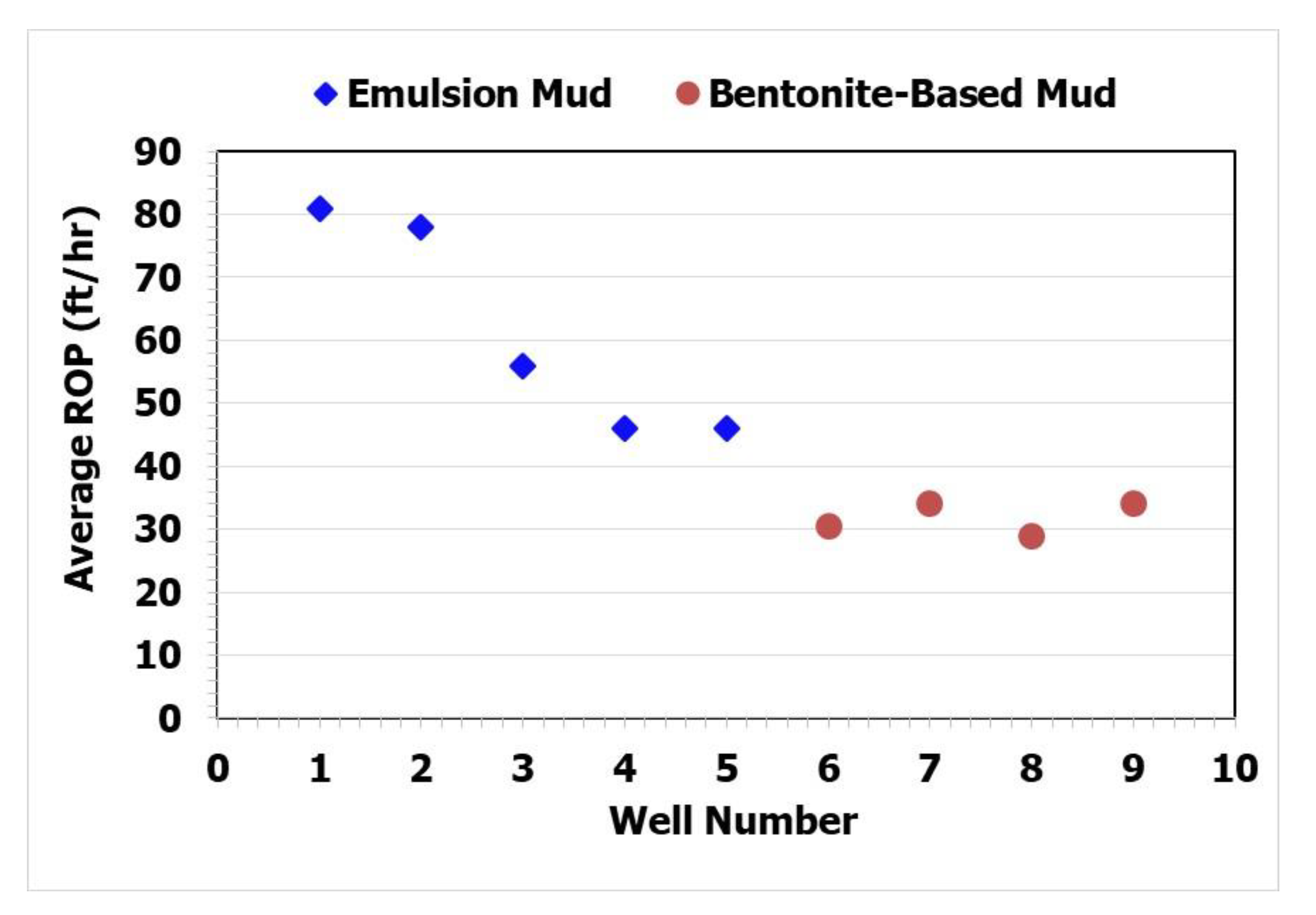
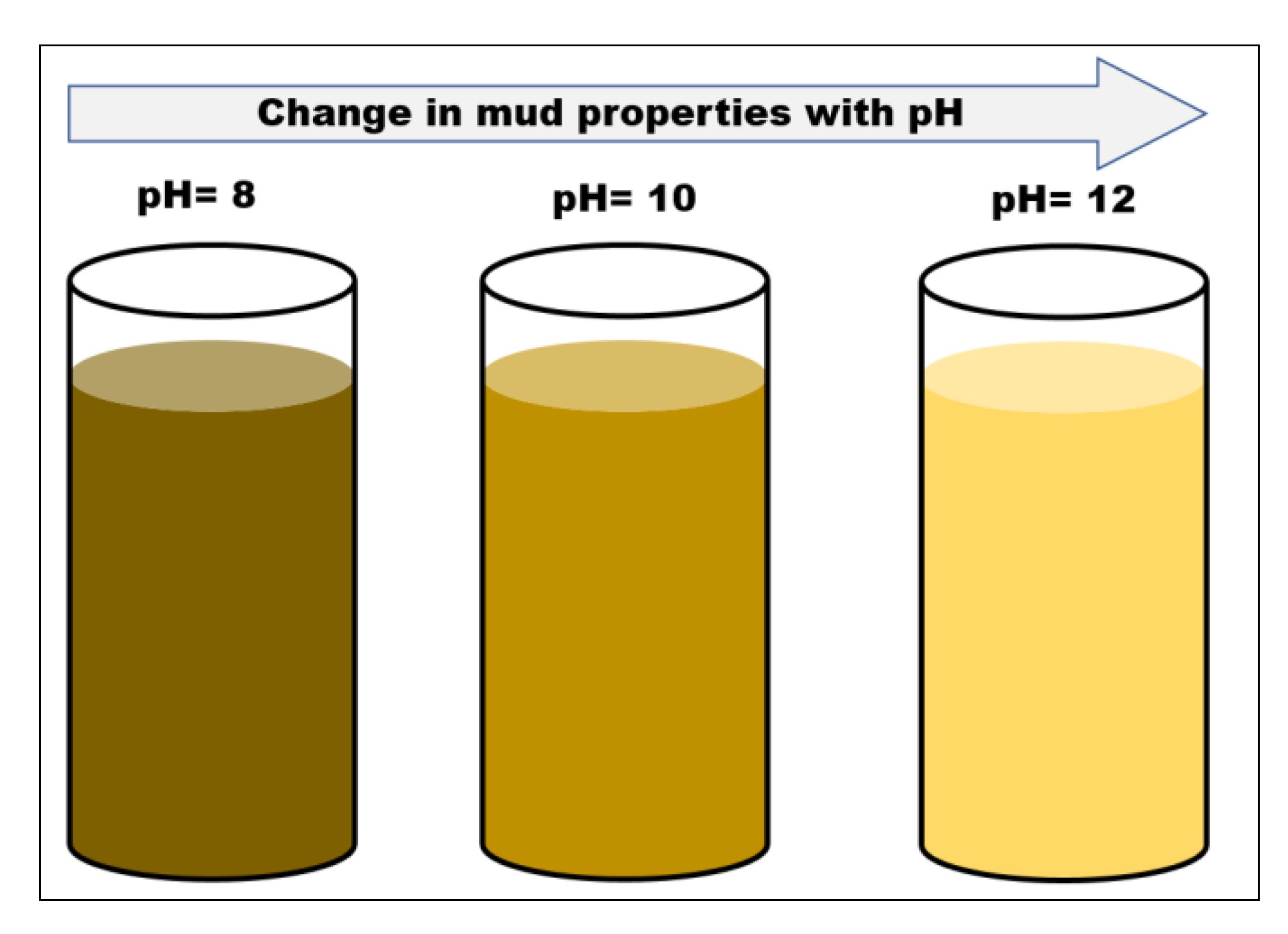
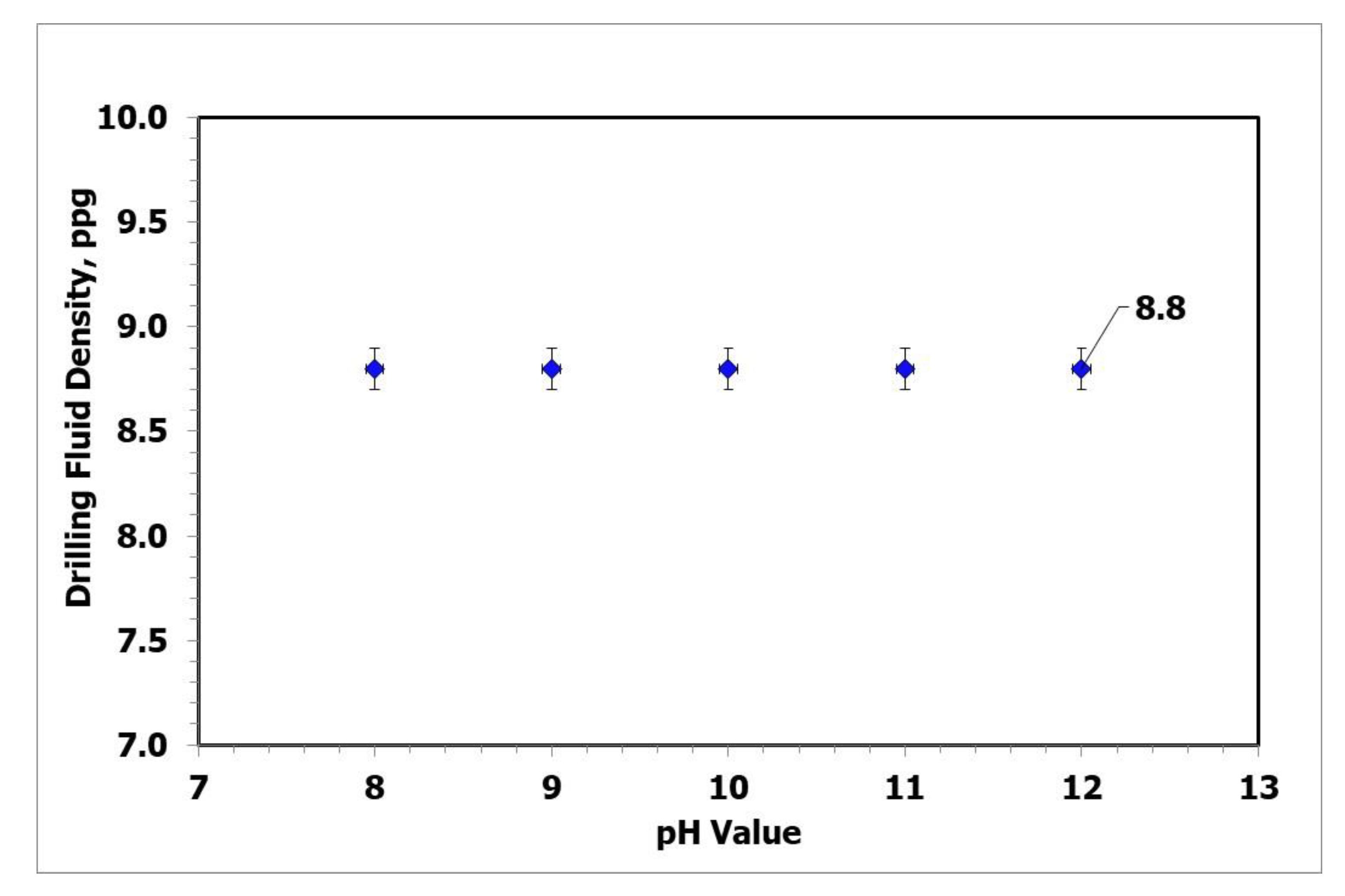
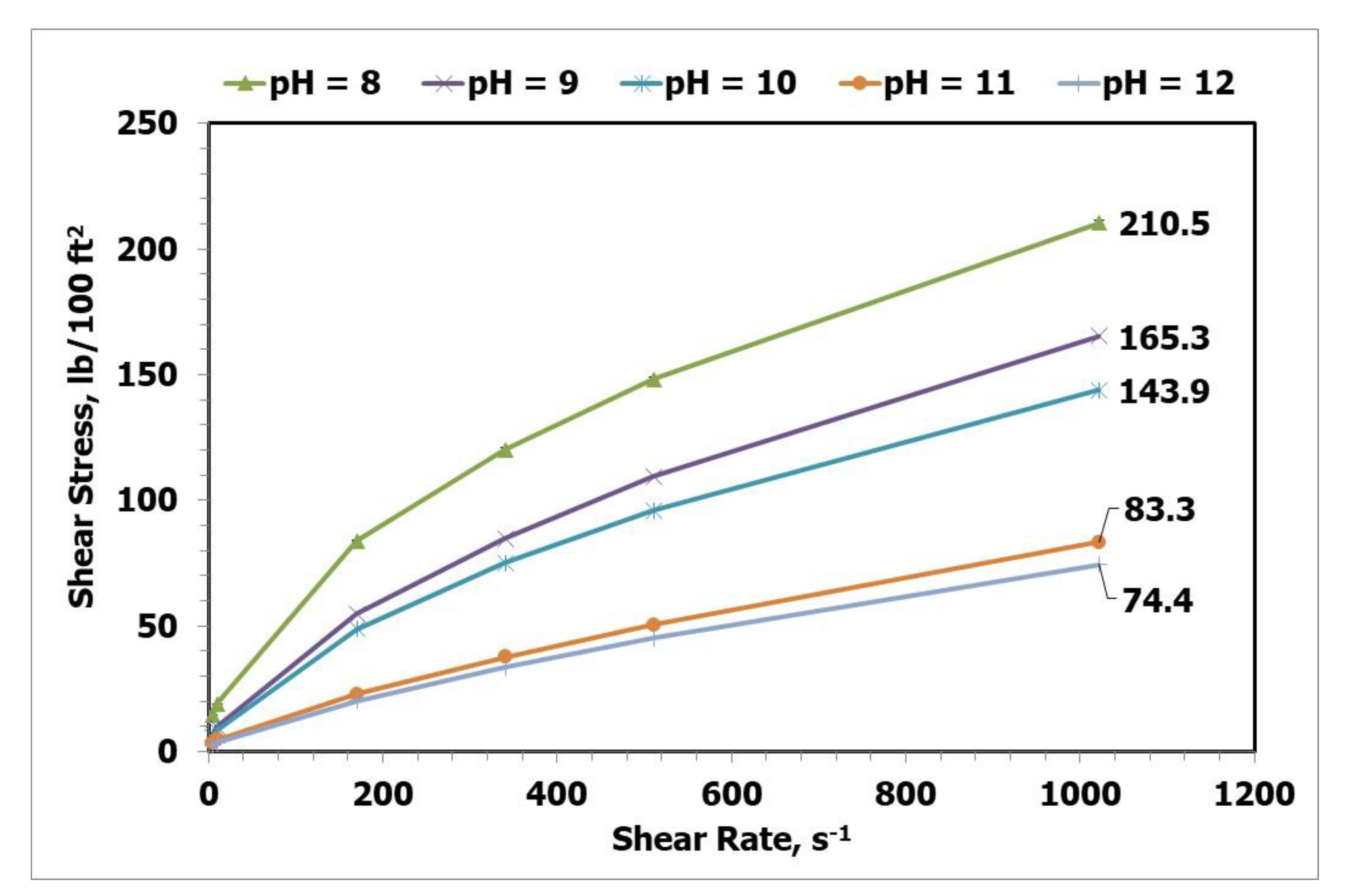

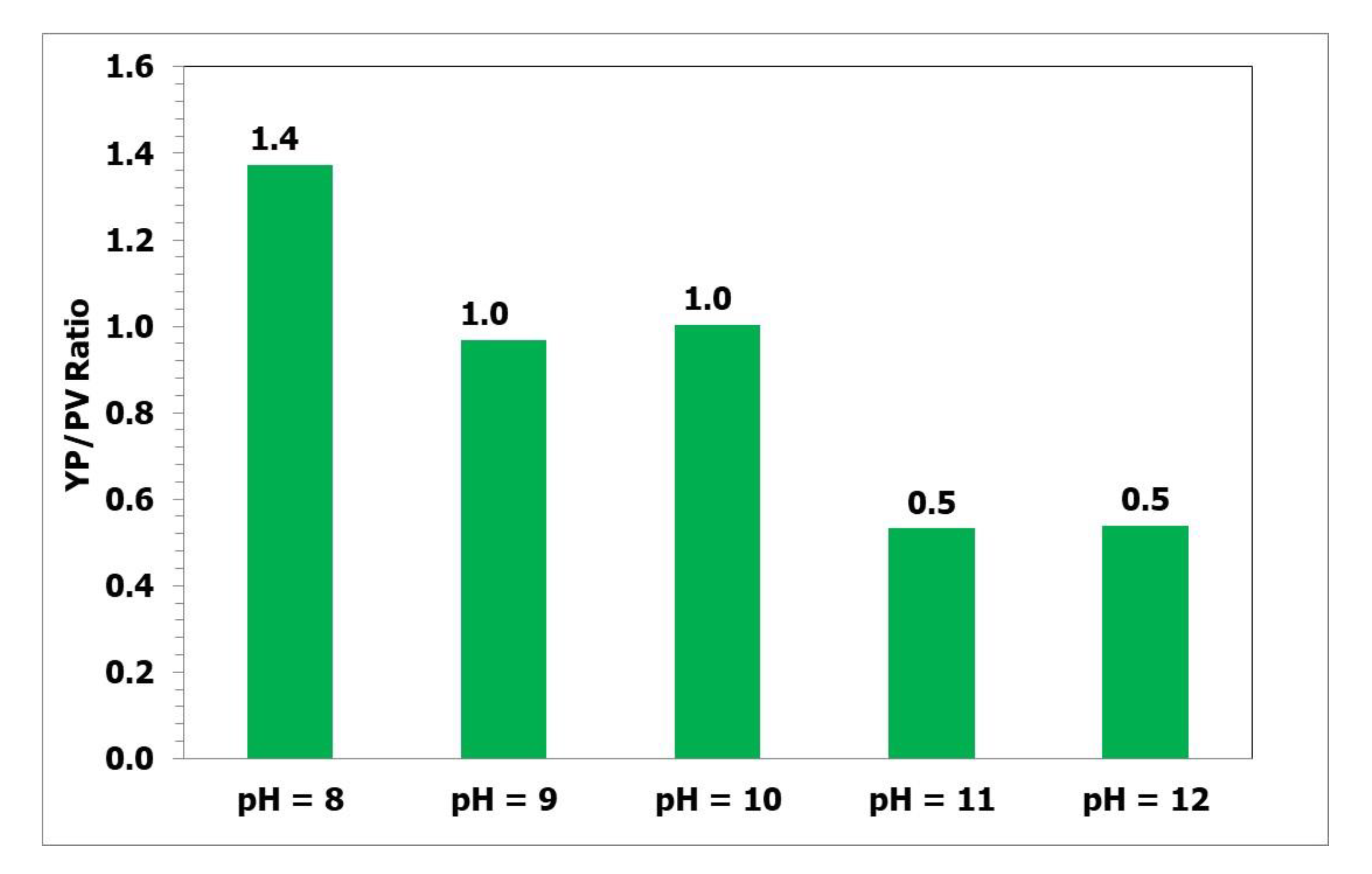
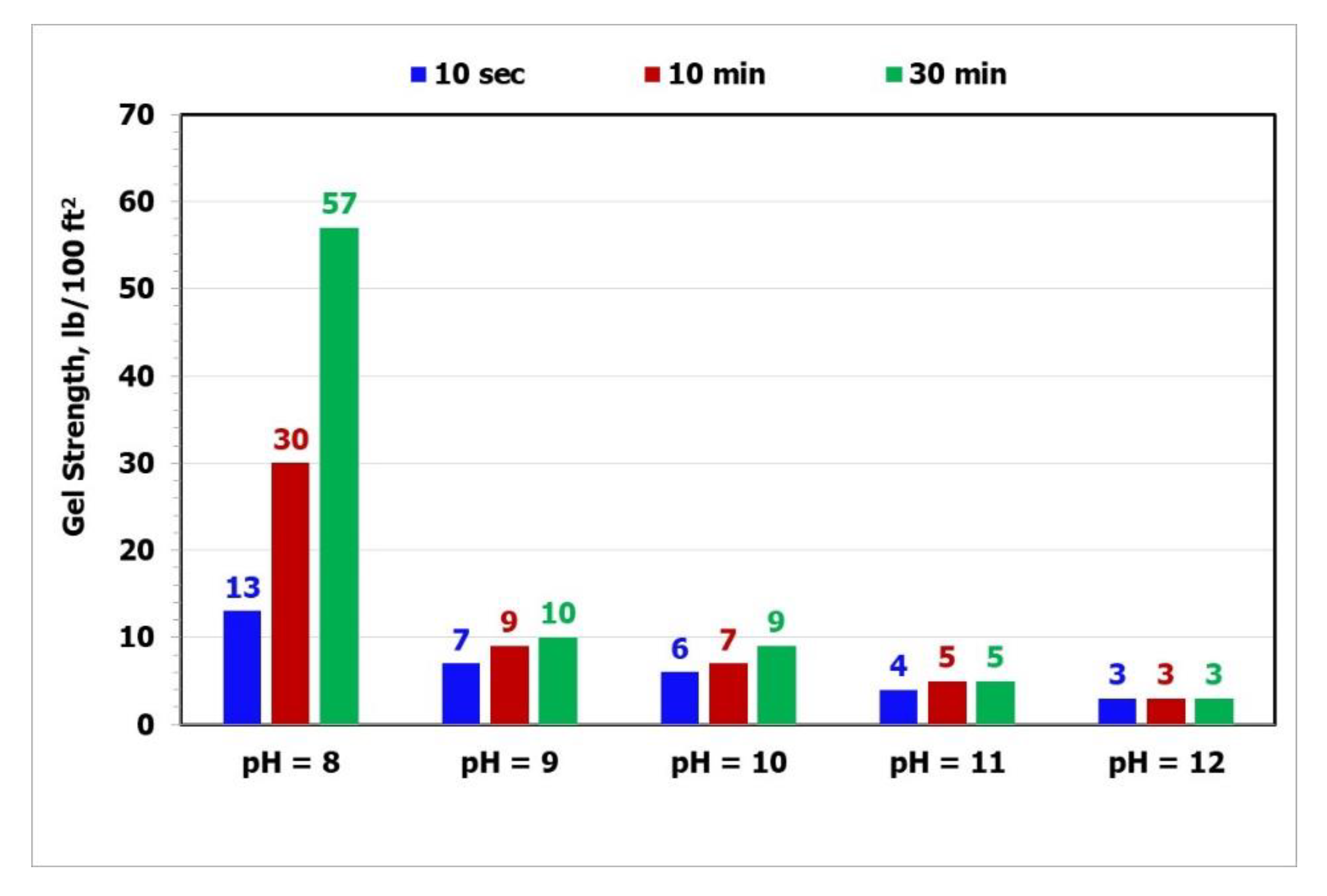


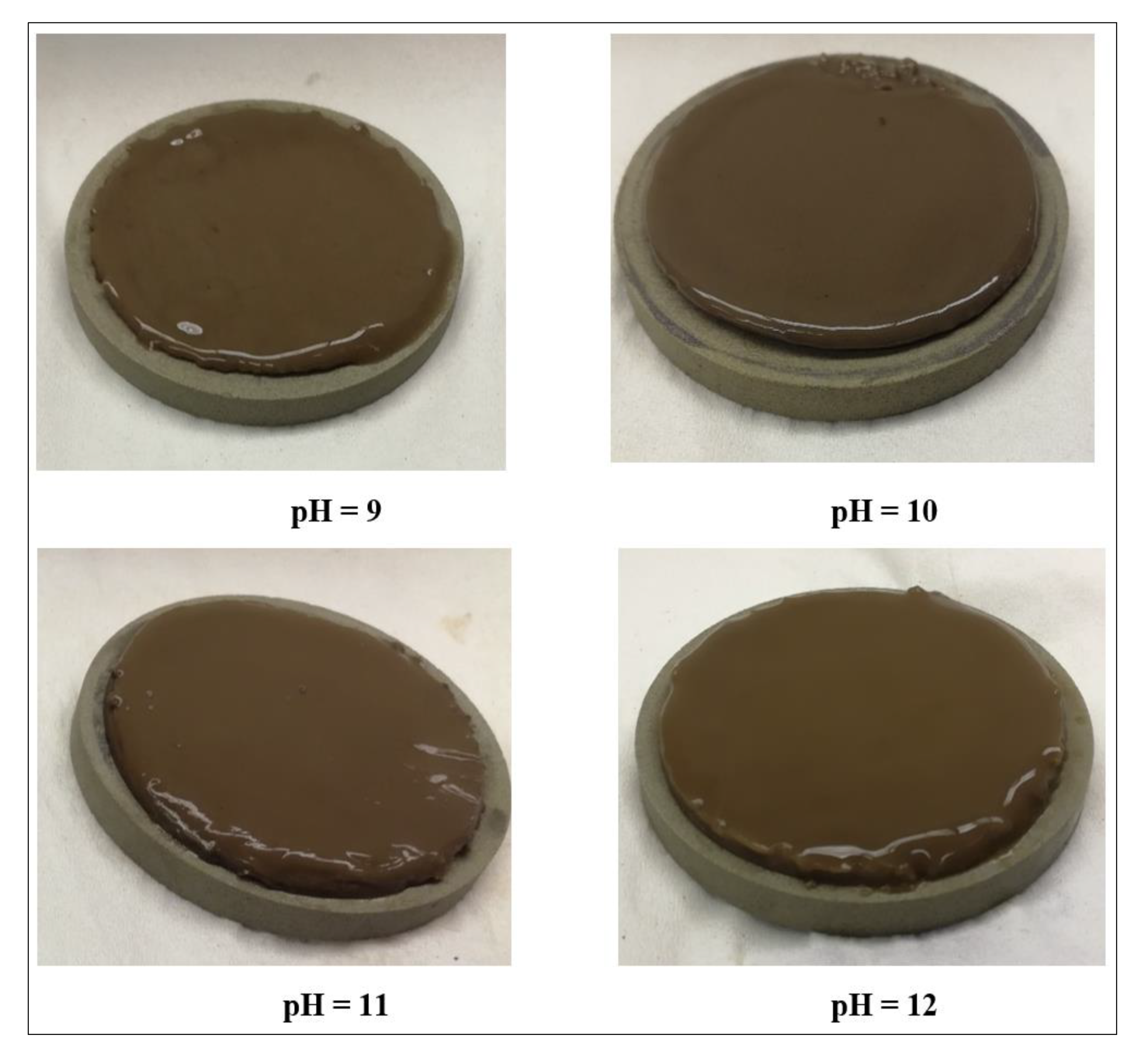
| Item | Amount, g | Function |
|---|---|---|
| Water | 340 | Base fluid |
| Bentonite | 40 | Viscosifier |
| Caustic Soda | 0.5 | Water Activity |
| Lignosulphonate | 3 | Dispersant |
| Starch | 3 | Fluid loss control |
© 2019 by the authors. Licensee MDPI, Basel, Switzerland. This article is an open access article distributed under the terms and conditions of the Creative Commons Attribution (CC BY) license (http://creativecommons.org/licenses/by/4.0/).
Share and Cite
Gamal, H.; Elkatatny, S.; Basfar, S.; Al-Majed, A. Effect of pH on Rheological and Filtration Properties of Water-Based Drilling Fluid Based on Bentonite. Sustainability 2019, 11, 6714. https://doi.org/10.3390/su11236714
Gamal H, Elkatatny S, Basfar S, Al-Majed A. Effect of pH on Rheological and Filtration Properties of Water-Based Drilling Fluid Based on Bentonite. Sustainability. 2019; 11(23):6714. https://doi.org/10.3390/su11236714
Chicago/Turabian StyleGamal, Hany, Salaheldin Elkatatny, Salem Basfar, and Abdulaziz Al-Majed. 2019. "Effect of pH on Rheological and Filtration Properties of Water-Based Drilling Fluid Based on Bentonite" Sustainability 11, no. 23: 6714. https://doi.org/10.3390/su11236714
APA StyleGamal, H., Elkatatny, S., Basfar, S., & Al-Majed, A. (2019). Effect of pH on Rheological and Filtration Properties of Water-Based Drilling Fluid Based on Bentonite. Sustainability, 11(23), 6714. https://doi.org/10.3390/su11236714






